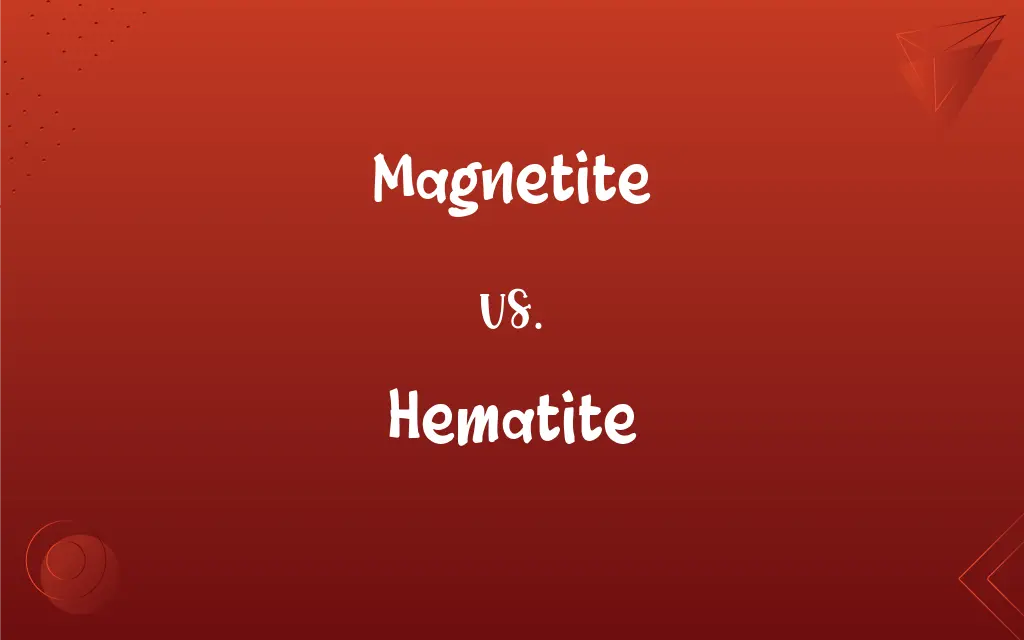Magnetite vs. Hematite: What's the Difference?
Edited by Harlon Moss || By Janet White || Published on October 12, 2023
Magnetite, with the chemical formula Fe₃O₄, is magnetic, while hematite, Fe₂O₃, is not and is typically more reddish-brown or silver.

Key Differences
Magnetite and hematite are both iron ores but have distinct characteristics. Magnetite, having the chemical formula Fe₃O₄, exhibits magnetic properties, whereas hematite, with a formula of Fe₂O₃, does not possess natural magnetism.
In terms of appearance, magnetite typically has a black or dark brown coloration and has a metallic luster. On the other hand, hematite can exhibit colors ranging from silver to reddish-brown and generally displays a metallic to dull luster.
Both magnetite and hematite play crucial roles in different industrial applications due to their iron content. Magnetite is often used in magnetic separation processes, while hematite is commonly utilized in the production of iron and as a pigment in paints due to its varied coloration.
The formations of magnetite and hematite also differ. Magnetite is usually formed in igneous or metamorphic rocks, whereas hematite is typically found in sedimentary environments, often as the result of the oxidation of magnetite.
The iron content in magnetite and hematite is also noteworthy. Magnetite generally has a higher iron content compared to hematite, making it more valuable in the pursuit of iron production.
ADVERTISEMENT
Comparison Chart
Chemical Formula
Fe₃O₄
Fe₂O₃
Magnetic Property
Magnetic
Non-magnetic
Color and Luster
Black or dark brown, metallic
Silver to reddish-brown, metallic to dull
Formation
Igneous or metamorphic rocks
Sedimentary environments
Iron Content
Generally higher
Lower
ADVERTISEMENT
Magnetite and Hematite Definitions
Magnetite
Magnetite is used in magnetic separation processes due to its magnetic nature.
The magnetic nature of magnetite enables its use in the removal of impurities from ores.
Hematite
Hematite is a non-magnetic iron ore, characterized by the chemical formula Fe₂O₃.
Hematite is often sourced for iron production due to its rich iron content.
Magnetite
Magnetite usually appears black or dark brown with a metallic luster.
The metallic luster of magnetite often distinguishes it from other minerals.
Hematite
Hematite can range in color from silver to reddish-brown and exhibit a metallic to dull luster.
The varied coloration of hematite makes it an attractive mineral for collectors.
Magnetite
Magnetite is a magnetic iron ore with the chemical formula Fe₃O₄.
Magnetite can be attracted by a magnet due to its inherent magnetic properties.
Hematite
Hematite is generally lower in iron content compared to magnetite.
The lower iron content in hematite impacts its utilization in iron production compared to magnetite.
Magnetite
Magnetite has a high iron content, making it valuable for iron production.
The exploitation of magnetite deposits is crucial for the iron and steel industry.
Hematite
Hematite is used as a pigment in paints due to its color variation.
Hematite provides a range of colors for artistic applications in paint formulations.
Magnetite
Magnetite is typically formed in igneous or metamorphic rocks.
The occurrence of magnetite in igneous rocks can be related to magmatic activities.
Hematite
Hematite is predominantly formed in sedimentary environments.
The presence of hematite in sedimentary rocks often indicates oxidized conditions.
Magnetite
The mineral form of black iron oxide, Fe3O4, that often occurs with magnesium, zinc, and manganese and is an important ore of iron.
Hematite
A black or blackish-red to brick-red mineral, essentially Fe2O3, the chief ore of iron.
Magnetite
(mineral) A magnetic mineral, Fe3O4, one of the primary ores of iron. It has also been called lodestone.
Hematite
(mineral) An iron ore, mainly peroxide of iron, Fe2O3.
Magnetite
An oxide of iron (Fe3O4) occurring in isometric crystals, also massive, of a black color and metallic luster. It is readily attracted by a magnet and sometimes possesses polarity, being then called loadstone. It is an important iron ore. Called also magnetic iron.
Hematite
An important ore of iron, the sesquioxide, so called because of the red color of the powder. It occurs in splendent rhombohedral crystals, and in massive and earthy forms; - the last called red ocher. Called also specular iron, oligist iron, rhombohedral iron ore, and bloodstone. See Brown hematite, under Brown.
Magnetite
An oxide of iron that is strongly attracted by magnets
Hematite
The principal form of iron ore; consists of ferric oxide in crystalline form; occurs in a red earthy form
FAQs
Are magnetite and hematite both iron ores?
Yes, both magnetite and hematite are iron ores with different iron content and properties.
Which one among magnetite and hematite has a higher iron content?
Magnetite generally has a higher iron content compared to hematite.
How does the formation of magnetite differ from that of hematite?
Magnetite is usually formed in igneous or metamorphic rocks, while hematite is typically found in sedimentary environments.
Is magnetite always black or dark brown?
Magnetite typically appears black or dark brown, but it can also exhibit other dark colors, depending on impurities.
Can magnetite be used in magnetic separation processes?
Yes, the magnetic properties of magnetite allow its use in magnetic separation processes.
Can hematite be used as a pigment?
Yes, hematite’s varied coloration makes it suitable as a pigment in paints.
How does the chemical formula of magnetite differ from that of hematite?
Magnetite has the chemical formula Fe₃O₄, while hematite has the formula Fe₂O₃.
What is the primary difference between magnetite and hematite?
The primary difference is that magnetite is magnetic, while hematite is not.
Is hematite magnetic like magnetite?
No, hematite does not possess natural magnetism like magnetite does.
Are the lusters of magnetite and hematite different?
Yes, magnetite generally has a metallic luster, while hematite can exhibit a metallic to dull luster.
Are magnetite and hematite valuable for industrial applications?
Absolutely, both are valuable for different industrial applications, including iron production.
Do magnetite and hematite have different environments of formation?
Yes, magnetite is associated with igneous or metamorphic rocks, while hematite is related to sedimentary environments.
Is the appearance of magnetite distinctive?
Yes, magnetite’s black or dark brown coloration and metallic luster make it distinctive.
Can the magnetic property of magnetite be used for ore purification?
Yes, magnetite’s magnetic nature enables its use in the removal of impurities from other ores.
Can hematite vary in color?
Yes, hematite can exhibit a range of colors from silver to reddish-brown.
About Author
Written by
Janet WhiteJanet White has been an esteemed writer and blogger for Difference Wiki. Holding a Master's degree in Science and Medical Journalism from the prestigious Boston University, she has consistently demonstrated her expertise and passion for her field. When she's not immersed in her work, Janet relishes her time exercising, delving into a good book, and cherishing moments with friends and family.
Edited by
Harlon MossHarlon is a seasoned quality moderator and accomplished content writer for Difference Wiki. An alumnus of the prestigious University of California, he earned his degree in Computer Science. Leveraging his academic background, Harlon brings a meticulous and informed perspective to his work, ensuring content accuracy and excellence.






































































